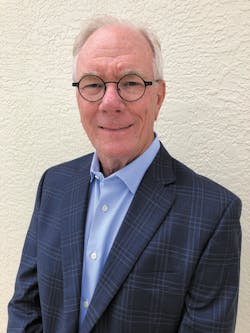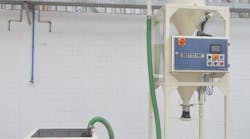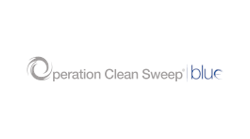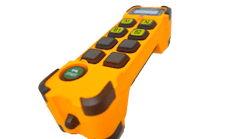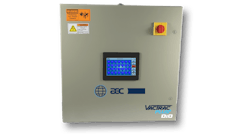Ferry Machine Co. was founded by Ernest Ferry in 1927 in Kent, Ohio, as a small machine shop for specialty engineered parts. That family business has evolved into Ferry Industries, the innovative maker of the RotoSpeed line of rotational molding machines, Femco bandsaws and Quintax CNC routers. Ferry Industries is credited with introducing the independent arm machine to the rotomolding industry and building the first four-arm, five-station machine.
Ferry’s machine line consists of 40 models, including carousel style, in-line shuttle, giant shuttle and rocking-oven machines. It has sold more than 1,300 machines in 65-plus countries.
The company’s evolution from small machine shop to rotational molding machine innovator began when a group of investors led by Harry Covington purchased the company in 1982. Covington, the company’s former owner and president, sold the company in 2014 to Chicago-based holding company Madison Industries. His son, Adam Covington, is now president and Harry — who was inducted into the Rotational Molding Hall of Fame in 2002 — is retired, working as a part-time adviser. He discussed the company’s evolution and the state of the industry with Bruce Adams, senior staff reporter at Plastics Machinery Magazine.
Where did you go to college?
Covington: I went to Virginia Polytechnic Institute, and I got a bachelor’s degree in mechanical engineering in 1964.
What was your first job out of college?
Covington: I was recruited by several companies, and I went to work for B.F. Goodrich Co. I moved from a very small town of 900 people in Virginia to Akron, Ohio. I was, as a young engineer, working in a division that made machinery for material handling and material dispensing. B.F. Goodrich sold that business, and in 1967 I went to work for one year at B.F. Goodrich’s chemical company in Avon Lake, Ohio, training to be a resin salesman. That was my first job in the plastics industry, but I wasn’t happy with that because I’m a mechanical engineer and I enjoy working with machines. So, I started looking for a job in machinery again. I called McNeil in Akron, which manufactured tire presses. They hired me in fall 1968, and I had a great career there.
What did you do at McNeil?
Covington: My first job with McNeil was in the sales department selling to key tire company accounts, such as Mohawk Tire and Armstrong Tire. It was a great job that provided great training working at a wonderful company that gave people a lot of opportunity.
In fall 1970, they made me manager of license engineering. McNeil licensed its manufacturing technology to allow companies in several countries to make tire curing presses for their local markets. My job was to field all the technical questions that came from the licensees every morning. I became deeply immersed in McNeill’s engineering technology, which was wonderful training.
Two years later, McNeil sent me to Italy to set up a technical office in Milan. I was the technical manager for all of Europe. My job was to coordinate with the European licensees in several countries and to work directly with customers to learn what they needed in the European market. All the while I was working in the tire press business with McNeil.
I spent two years in Europe for McNeil, and then I came back to the U.S. and was named international sales manager for McNeil. I was handling all our export sales for tire presses to parts of the world where we didn’t have licensees.
McNeil also had a product line called Rotocast, which was a very small line of rotational molding machines. It was a small business, about $1.5 to $2 million a year. They also bought a company called Femco out of Cuyahoga Falls, Ohio, and they kept it as a separate division. Femco made bandsaws for cutting flexible foam for mattresses, pillows or for packaging furniture.
In 1976, I was named sales manager for McNeil Akron. I was responsible for the tire presses, the rotational molding machines and the bandsaws. The rotational molding machinery and the bandsaws were a small part of McNeil’s business. The two together were about $3 million in business. At that time, McNeil Akron was about a $35 million-a-year company, so those were less than 10 percent of the total business.
In 1979, things changed rapidly for me. McNeil Akron was part of the McNeil Corp., which had five or six major divisions. McNeil Akron was the cornerstone division that founded the company. But the corporation sold McNeil Akron to a French group in 1979 and that changed the business quite rapidly. When the French bought the company, they didn’t want the Femco bandsaw business. So, I sold that business in 1980 to the Ferry Machine Co. in Kent, Ohio.
Was Ferry in plastics at that time?
Covington: No. Ferry was a job shop, a small machine shop with about 20 employees. They didn’t have their own product line. They were like hundreds of small machine shops in the Akron area. They worked for several companies, but they didn’t build complete machines. They built machine components. They were a very fine company.
Long before I became acquainted with the company, Ernest Ferry and his brother stepped out of the business. They had retired and hired management that wasn’t doing a very good job with the business. But they bought Femco with the thought they could have their own product line, revive the business and take it to another level. In fact, it had the opposite effect. They had never had their own product line, they didn’t have an engineering staff, they didn’t have a culture of designing and building their own product and standing behind it with a warranty while absorbing any overruns on cost. This business is different from a job shop.
Ferry started hemorrhaging money, and I think sometime in 1981 they came to me and asked if I would run the company. I said no, but I’d like to buy it. They said it wasn’t for sale, but about six months later, they came back and said they would consider selling me an interest in the company. At the end of 1981 and the beginning of 1982, I started putting together a plan to buy the company and we consummated the deal to buy the company at the end of September 1982.
What inspired you and a group of investors to buy Ferry?
Covington: What inspired the group was me. After McNeil was purchased, I was not unhappy with the new ownership from France, but I was having entrepreneurial ideas, and I wanted to be in business for myself. I had a lot of experience in sales and engineering for McNeil. I had an overseas role with McNeil where I had a lot of autonomy. When I came back, I didn’t think there was much headroom for me other than being president and they had brought in an outside guy to be president. I thought it’s time to move on. I started looking for companies to buy and the Ferry deal came along and eventually worked out. As a young guy, I didn’t have enough money to buy a big company. I had a close friend in Texas, who invested with me, and I brought in three other investors. I bought all of them out many years ago. I was the majority investor and none of them ever worked in the business.
How did you know it was the right time to buy Ferry?
Covington: I had a drive. It was something I wanted to do, something I had to do. I’ll use a tried and trite expression, “failure was not an option.” We went through some very tough times, but we persevered. There were so many things I didn’t know about dealing with people, dealing with a union, raising capital, managing finances. I was an engineer and a salesman. I had a lot to learn. When you’re a small business, you wear lots of hats. Fortunately, I had some smart people working for me. We worked very hard and we solved problems and moved on and became very successful.
When you got that group together to buy Ferry, did you anticipate transitioning the company to making rotomolding machines?
Covington: No, but I had a plan to increase business. I contacted Orme the summer before I bought Ferry. I knew Ferry’s business would not be enough to sustain the company. But I didn't want to compete with McNeil and copy what they did. I abhor operations that copy somebody else. We wanted to do our own thing and we did it. Initially we called it a Ferry Orme machine, but we only did that for a year or so. We changed their design so much that I didn’t want to use their name anymore. We paid them a royalty for quite a few years until we bought them for their know-how. We had a great relationship and they were supportive. We were good friends. I bought them out and I hired all the Orme people to work for me.
How did you transition Ferry into a rotomolding equipment manufacturer?
Covington: I knew Ferry needed more business, so I went to Europe and visited Krupp in Germany for their tire machinery division and Orme [Polymer Engineering] in England for their rotational molding machinery. I came back, and a few months later we had a contract with Krupp to sell their machinery in the U.S. that didn’t compete with McNeil, and an agreement with Orme to produce their rotational molding machinery in the U.S.
That was a big turning point for Ferry and for me. We had a lot on our plate as a young company because nobody except me had any experience doing any of this type of work. I had to build a team to do that. Eventually, I helped Krupp set up their own business in Kent, Ohio, and ended up on their operating board.
What challenges did you encounter as you grew your business?
Covington: In the early days, it was financial. The first two years I had the business were horrific. The company was nearly bankrupt when I bought it and I thought I’d finish the job off before turning it around. We didn’t have enough money, but we mustered through until we got ourselves established.
The capital goods business is always a bit of a roller coaster. You’re very busy, you’re climbing up and you can hardly keep up. Then it goes over the top and there’s extra capacity in the industry and you don’t have as much business, so you’ve got to manage it on the downslope. But we didn’t have too many deep lows. Our business dropped dramatically in the 2008-2009 recession, but we didn’t suffer financially very badly. I had a great team of people. I was blessed to have people who not only were skilled, but they took direction, they gave direction and they were very supportive.
Did the Orme rotomolding machines compete with McNeil’s business?
Covington: When I left McNeil, I did not want to copy the McNeil rotational molding machine or do anything that infringed on them. I spent 15 great years there, I had great respect for the company, and I wanted to do something on my own. By taking the Orme license, we were completely separate. McNeil’s machines were what they called traditional fixed-turret, three-armed machines with tire drive. The Orme machines were completely different. They were direct-drive, which was more efficient. Orme was a very small company that only did about $2 million a year in business, so they didn’t have a lot of technical support to offer us. Very quickly I realized that Orme’s engineering was different and was not going to be easily produced in the U.S., so we set about to change the product to suit our market and what we wanted it to do.
When was your first machinery breakthrough?
Covington: I think in 1984 we introduced the Ferry independent-arm rotational molding machine. It wasn’t the Orme design, it was our design, based on their know-how. People were kind of skeptical at first because it was a four-arm, five-station machine that they hadn’t seen before. Every arm on the machine could carry a different load, move at a different speed, have different cycles in the oven and different cycles in cooling. It was unheard of in the rotational molding industry.
What inspired you to design a four-arm, five-station machine?
Covington: I have to give credit to one of our customers, Jim Clutter, who wanted us to modify a machine for him, so we made a five-station machine as an experiment. That changed our business. From that point forward, we only built five-station, independent-arm machines with up to four arms.
This allowed the industry to improve its cycles and to carry more weight on one arm than had ever been carried before, and to make larger machines by a massive amount than had ever been built in the industry before. By comparison, McNeil’s largest machine could carry about 2,000 pounds and had a swing capacity of about 120 inches. Soon, our biggest machine had a swing capacity of 180 inches and could carry 5,000 pounds on one arm. The cycles could be different so that you could run the machine, as though each arm was a machine. They shared an oven and a cooling chamber, but each arm had its own processing setup. That was a big change for the industry, and Ferry can take credit for having developed and promoted it, and it has become the standard of the industry globally today. It was innovative and expandable, and as time went on, we built more and larger models that could carry more weight.
Once we got the four-arm, five-station machine concept firmly implanted in the industry, we continued to develop new things. We were the first company to put dual passage and triple passage air on a machine. We were the first to fully computerize a rotational molding machine. For many years, we built the largest machines ever built in the industry, in terms of swing capacity and weight capacity. We hit these milestones because we were willing to take risks. These were calculated risks because they often were backed by customers’ needs. We were extraordinarily fortunate to have some very supportive customers.
What were some other accomplishments?
Covington: Around 1985-86, we introduced computers to run the machine, which provided a lot more processing variables than had ever been available to the industry. That helped us establish ourselves as a premier machinery company in the rotational molding industry. Early on we saw some mechanical needs with the independent-arm machine. The industry was slow to react and didn’t have process development systems available. So, we teamed up with Queen’s University in Ireland to market their RotoLog, which was the first and is still the best system for measuring the state of cure of the product when it’s in the process. We ultimately bought the product line from the Queen’s group and we own and market it today.
In 1991, our friends in England — Orme — were having some financial problems and we bought the assets of that company and set up our own company, called RotoSpeed Ltd., in England. We operated that company for quite a few years. We built quite a beachhead in the European market and we still supply the European market.
In 1994, we developed our first in-line shuttle machine. We were the only machinery manufacturer to show at the Association of Rotational Molders’ initial Rotoplas show. We showed a machine with a shuttle that was our first entrée into that market.
What overseas markets is Ferry now active in?
Covington: Today we have machines in 65-plus countries around the world including China, Japan, Indonesia, Malaysia, Australia, New Zealand and almost all the South American countries. We’ve got quite a network around the world that we service from Ohio and from Europe. We’ve learned a lot from our customers. We’re not geniuses. Our customers have needs and we try to implement a solution for their needs and as we do that it helps us grow our intellect and our product lines. It’s been kind of a handshaking business in many cases to help us grow the business.
How did you get into five-axis CNC router machines?
Covington: In addition to rotational molding machines we were selling bandsaws to the flexible foam industry. As part of that business, we had a product line that cut structural honeycomb for the aircraft industry. We sold that to companies that made honeycomb and to aircraft frame manufacturers, customers like Boeing and Airbus. In the mid-1990s we saw a tendency of customers in the rotational molding industry starting to use three-axis and five-axis routers to trim product. We saw the same thing going on in our structural honeycomb business where the airline manufacturers were using routers to trim and shape honeycomb for aircraft parts. We started to design and build our own five-axis router. We fortunately stumbled upon a company called Canton Industrial Systems in Canton, Ohio, which made five-axis routers. We bought them in 1998, and it was a great addition to our product line. We renamed the product Quintax and it was quite a successful business. We were able to sell that product to the rotomolding market, to the thermoforming market and to the aerospace market for trimming structural honeycomb. It was a nice boon to the business.
What other companies did Ferry acquire?
Covington: In 1990, we bought FSP, one of our competitors out of Canada. FSP made a product called the clamshell, which was a unique, single-station rotational molding machine. They were going through a very tough financial time and the president and owner was a friend and I called him to ask if he’d be interested in selling and he sold us the product. After five or six years we didn’t produce that product anymore because the single-station shuttle machine could do the same as a single-station clamshell machine. We sort of parked the clamshell machine. We can still build it, but we find it’s expensive to build compared to traditional shuttle machines. We don’t use that technology anymore, but we do support it.
In 1994 or 1995, we bought the assets of McNeil Akron’s rotational molding product line. We still supply parts for that product line. We amalgamated the McNeil, the Orme and the FSP product lines into Ferry over the years.
Did the Orme deal give you access to new overseas markets?
Covington: Yes. My overseas experience taught me how to deal in certain countries. I didn’t know the rotational molding market in those countries, but I knew how business was done. When we paired up with Orme in 1982, we couldn’t sell to Europe. When we bought them in 1991, that opened it up and we were able to have our business in Europe selling to the European market and to Russia.
What are milestones that Ferry reached during your tenure?
Covington: Gaining acceptance of the four-arm, five-station machine was a massive milestone. It was a milestone for Ferry and for the industry, because it changed the way the industry was able to do things globally. It didn’t exist before we introduced it.
Another milestone was the acquisition of Orme and setting up our own factory in Europe to supply the European market. Acquiring the Quintax three-axis and five-axis router line was a milestone. There were a lot of baby steps in between.
To what do you attribute the company’s success?
Covington: Teamwork comprised of our customers, our suppliers and, most of all, the Ferry people. That’s the thing that made it work. It’s not one person, not one ingredient, it’s everything. Nobody is successful on their own. It takes a combination of great employees, suppliers and customers.
When did you sell Ferry?
Covington: In 2014 I was approached by a private holding company out of Chicago called Madison Industries about selling the company. Madison had owned a couple of rotational molding companies that had bought Ferry machines, so they knew who we were. They didn’t own those companies anymore. They’d gotten out of the plastics molding business. But they were expanding their machinery side. They bought Ferry at the end of 2014. We were the first company in a new silo called Madison Industrial Solutions. They’ve got five or six business groups, but Madison Industrial Solutions is their machinery side and we were the first company in that group. It’s been extremely successful for us, and, I think, for them. The company has done well. They’ve given us management support where we need it. We’ve been able to manage on our own financially.
I retired officially two years ago, but I continued to work some last year. I still do some part-time consulting work for them. But I’m not there on a day-to-day basis. Last fall, my son Adam was named president of Ferry and he’s doing a great job. He joined the company as a sales engineer years ago.
Why did you decide to sell to Madison?
Covington: We had been approached many times by private equity companies, but that wasn’t a model that I thought was for a long-term business. Private equity companies often want to buy a company, keep it three to five or seven years and then flip it for a profit. I was concerned about our employees, our customers, the support of our product, and I didn’t want to go in that direction. Madison is a different company. It is a private holding company. They buy companies for the long-term to build a big portfolio. They did what they said they would do when they made their offer. I’m very happy with them.
In your early years, who was your mentor?
Covington: I’d have to go back to my McNeil days. I had two extraordinary bosses there. Rowland Raeburn, who was vice president of engineering, who expressed a huge confidence in me and Ed Schrank, who was president. Ed was a great mentor. He pushed me, he cajoled me, he made me think outside the box and he selected me to go to Europe for two years. He would give me an assignment and he expected results. He didn’t want me to come in every morning and ask, “How do I do this, boss?” I learned a lot about being an entrepreneur.
What do you see as the next phase of machine development or automation?
Covington: I think you’ll see automation, but it will not be broad-based because some of the things that make our industry smart and usable are not going to be able to be automated. Very large parts, some of the complex parts and parts in very low quantities will be hard to automate. Parts that are repetitive with high volume will be able to be automated and that is being done already. I think we’ll have an industry where parts of a company may be automated, and other parts of the company may not be as automated.
One thing that makes rotational molding a successful business is we can make large, hollow parts economically. Two, we can make short runs of products economically. Three, the process is very flexible to change. Four, we can make very complex shapes economically. Some of those complex shapes are going to be difficult to make in automated machinery, but we can semi-automate many parts. These are some of the tenets of the rotational molding industry and I don’t see that changing.
Where do you see the rotomolding industry 10 or 20 years from now?
Covington: When I look back 20 or 30 years, we’ve come a long way. Parts today are much more complex. The finish is extremely better. When you have interlocking parts, the fit is much better because tolerances are tighter.
I think our limitation is going to be the types of materials that we can mold. Today, about 90 percent of what is rotomolded is polyethylene. There’s some nylon, which has got great applications for certain things, and there is some urethane used, but we need more materials that are rotomoldable in order to move into new types of businesses.
The industry will continue to grow. It will have its challenges from blow molding, but I still think that there are characteristics of rotomolding that will far exceed the characteristics of blow molding in many products. In terms of strength, durability and weatherability, I think rotomolding will always be better.
What do you consider your strengths?
Covington: I’m not the best detail design engineer, but conceptually I’m very good at understanding problems, conceiving products, being able to relate those to a team and getting a product out the door.
Are you enjoying retirement?
Covington: I’m finding it difficult to retire. I like the challenge of getting up every morning and going to work.
Do you have any hobbies?
Covington: I’ve had a long-term hobby with automobiles. I like to work on cars. I have several Porsches in a small collection. I’m a vintage sports car racer, but I think I’ll wind that up because I’m getting too old for it.
How would you like to be remembered? What legacy would you like to leave behind?
Covington: As [the leader of] an innovative company that introduced the independent-arm machine to the rotomolding industry.
Just the facts:
Who: Harry Covington, former owner and president of Ferry Industries Inc., now retired
Headquarters: Stow, Ohio
Founded: 1927
Age: 77
